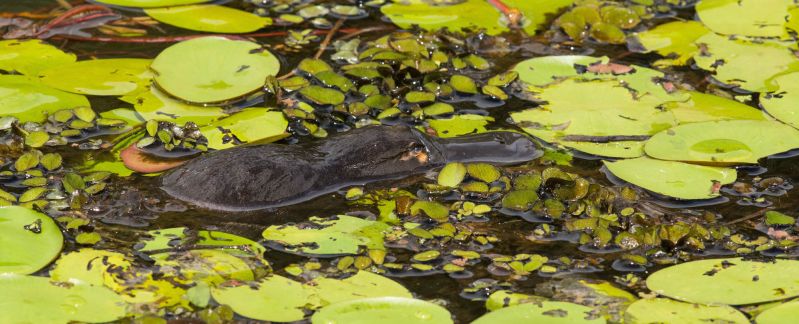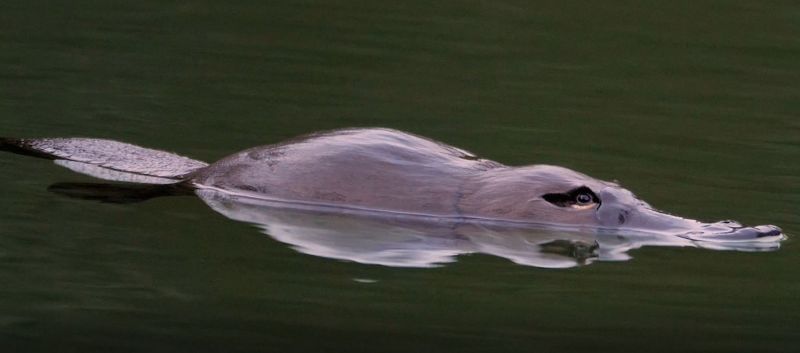The Platypus (Ornithorhynchus anatinus) is an iconic egg-laying mammal endemic to eastern and south-eastern Australia.
Where are Platypuses (also Platypi) found in Australia?
Platypuses are found in freshwater systems along the eastern and south-eastern coastline of Australia, including the island state of Tasmania. They are often sighted floating along the top of the river, looking for food, but are quite elusive so it often takes some time, patience and silence to catch a glimpse.
Along with the Short-beaked Echidna and Long-beaked Echidna (not found in Australia), the Platypus is a rare egg-laying mammal, called a monotreme.
What are the physical features of the Platypus?
There is no doubt - the Platypus is a strange looking creature. Covered in brown fur and featuring a bill, a big flat tail and webbed feet, the Platypus resembles something between a duck and an otter!
Males are approximately 25% larger, and have a poisonous spur their hind legs, which are thought to be used as a defensive tool to fend off competing males.

Platypus reproduction, gestation and birth
In general, breeding begins in late winter/early spring (August-September), however in northern Australia (see Cairns), breeding begins in winter (June-August), and in Tasmania, breeding begins later (November-January).
After a gestation period of just 21 days, the female will lay between one and three eggs (most common is two) and then incubate them in a nest in her burrow. After 10 days of incubation, the eggs will hatch and the mother will begin to feed them with milk through her mammary gland, which essentially secretes milk through the skin.
After three to four months in the burrow, the young will emerge.
The Platypus diet
The Platypuses bill, which is full of electroreceptors, assist it in finding molluscs, crustaceans and other invertebrates in murky water.
On the water surface, they will feed on insects (such as dragonflies and mosquitos) and water beetles.
Platypuses have also been observed feeding opportunistically on small fish, tadpoles, snails and worms.

Conservation status
The Platypus has been considered common across most of its range, however recent studies indicate that there is a growing list of declines and localised extinctions.
There are a couple of organisations in Australia who are doing some great work to support these fascinating creatures, including:
Best opportunities to see a Platypus
The best chance of seeing a Platypus is at dawn or dusk, and with an expert guide.
Where can I see the Platypus with an expert guide?
5 Day Tasmanian Wildlife and Wilderness Encounter
Operator: Premier Travel Tasmania
Region: Tasmania
Tasmania, Australia’s island state, provides a rare opportunity to encounter unique and endemic wildlife. Renowned as a prime area for marsupial and monotreme spotting, Tasmania is a crucial habitat for many species, including echidnas, platypuses, quolls, kangaroos, wallabies, wombats and the most famous resident, the Tasmanian Devil.
East Gippsland Wildlife Journey
Operator: Echidna Walkabout Nature Tours
Region: East Gippsland, Victoria
Venturing across East Gippsland’s magnificent lush rainforests, coastal heathlands, giant eucalypt groves, white sandy beaches and pristine rivers and estuaries, this four day immersive adventure offers you encounters with an incredible array of species.
Tablelands & Crater Lakes
Operator: FNQ Nature Tours
Region: Cairns, Queensland
On this epic day adventure, you will experience a spectacular mix of habitats across the Atherton Tablelands; from lush rainforest, volcanic lakes, wetlands through to savanna country. Located in the highland region southwest of Cairns, this tour covers landmarks such as the Cathedral Fig Tree, Lake Barrine and Milla Milla Falls, and opportunity to spot the Platypus and Tree Kangaroo.
Southern Highlands Wildlife Day Tour (1D)
Operator: Boutique Wildlife Tours
Region: Southern Highlands, New South Wales
Venture to the pristine bushland of the Southern Highlands, just 90 minutes from Sydney, to observe several of Australia's most iconic species in the afternoon and evening! Guests will escape the busy city afternoon to the tranquil environment of the Southern Highlands in search of Australia’s most beloved species including wild Eastern-grey Kangaroos, Koalas, Red-necked Wallabies, Common Wombats, Platypus and many bird species.

